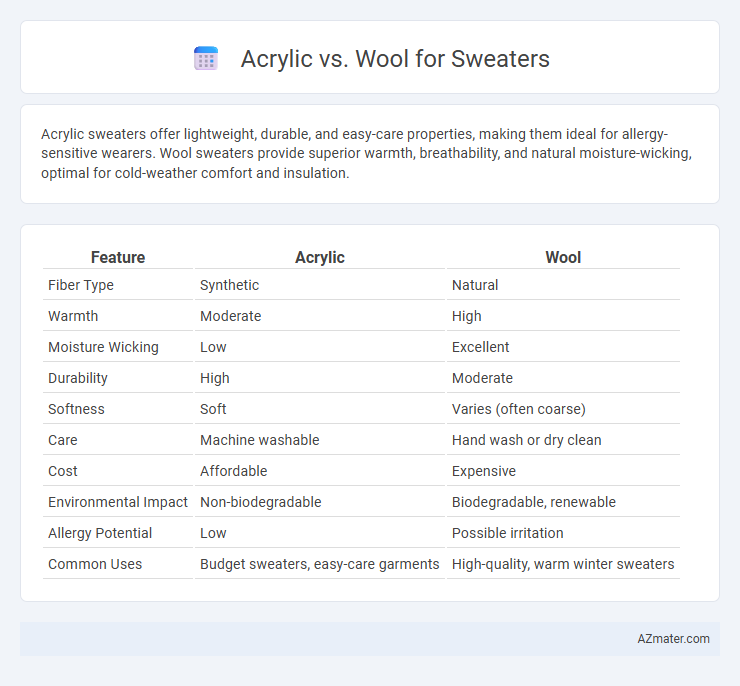Acrylic sweaters offer lightweight, durable, and easy-care properties, making them ideal for allergy-sensitive wearers. Wool sweaters provide superior warmth, breathability, and natural moisture-wicking, optimal for cold-weather comfort and insulation.
Table of Comparison
| Feature | Acrylic | Wool |
|---|---|---|
| Fiber Type | Synthetic | Natural |
| Warmth | Moderate | High |
| Moisture Wicking | Low | Excellent |
| Durability | High | Moderate |
| Softness | Soft | Varies (often coarse) |
| Care | Machine washable | Hand wash or dry clean |
| Cost | Affordable | Expensive |
| Environmental Impact | Non-biodegradable | Biodegradable, renewable |
| Allergy Potential | Low | Possible irritation |
| Common Uses | Budget sweaters, easy-care garments | High-quality, warm winter sweaters |
Introduction to Acrylic and Wool Sweaters
Acrylic and wool are popular materials used in sweater manufacturing, each offering distinct benefits and qualities. Acrylic sweaters are lightweight, durable, and often more affordable, making them a common choice for casual wear, while wool sweaters provide superior insulation, breathability, and natural moisture-wicking properties, ideal for colder climates. Understanding the differences in fiber composition and performance helps consumers select the right sweater based on comfort, warmth, and care requirements.
Material Composition: Acrylic vs Wool
Acrylic sweaters are made from synthetic fibers designed to mimic the softness and warmth of wool while being more affordable and easier to care for. Wool sweaters, sourced from sheep fleece, offer superior natural insulation, breathability, and moisture-wicking properties, making them ideal for colder climates. Both materials vary significantly in durability and softness, with wool generally providing better heat retention and acrylic being more resistant to moth damage and shrinkage.
Warmth and Insulation Properties
Wool fibers provide superior warmth and insulation due to their natural crimp, trapping air effectively to retain body heat even in damp conditions. Acrylic, a synthetic fiber, mimics some insulating properties but generally offers less thermal regulation compared to wool. Wool's breathability and moisture-wicking capabilities enhance comfort, making it the preferred choice for high-performance cold-weather sweaters.
Durability and Longevity
Wool sweaters offer superior durability and longevity due to their natural resilience, moisture-wicking properties, and ability to maintain shape over time. Acrylic sweaters, while more affordable and resistant to moths, tend to pill and wear out faster with frequent use. Choosing wool ensures a longer-lasting garment that withstands regular wear and retains warmth effectively.
Comfort and Softness
Acrylic sweaters offer a lightweight, hypoallergenic option with a smooth texture that mimics wool's softness but tend to be less breathable, which can affect comfort during extended wear. Wool sweaters provide superior warmth and natural moisture-wicking properties, delivering a plush, soft feel that improves with age; however, some types like coarse wool may cause itchiness or irritation against sensitive skin. Choosing between acrylic and wool depends on individual sensitivity and climate, as wool excels in insulation while acrylic suits those desiring easy-care softness and lighter warmth.
Care and Maintenance Requirements
Acrylic sweaters require less maintenance compared to wool, as they are machine washable and resistant to shrinking or moth damage, making them ideal for easy care. Wool sweaters need gentle hand washing or dry cleaning and must be dried flat to maintain shape, as they are prone to shrinking, felting, and damage from heat or agitation. Proper storage of wool garments in breathable containers with moth repellents is essential to preserve longevity and softness.
Breathability and Moisture Wicking
Acrylic sweaters offer moderate breathability but tend to trap heat and moisture, making them less effective at moisture wicking compared to wool. Wool excels in breathability due to its natural fiber structure, which allows air circulation and enhances moisture-wicking properties by absorbing sweat and releasing it into the air. This makes wool sweaters ideal for regulating body temperature and maintaining comfort in various weather conditions.
Environmental Impact and Sustainability
Acrylic sweaters are made from synthetic fibers derived from petroleum, contributing to higher carbon emissions and non-biodegradable waste, which negatively impact the environment. Wool, as a natural and biodegradable fiber, offers greater sustainability by supporting renewable farming practices and reducing microplastic pollution. However, wool production's environmental footprint varies depending on farming methods, with sustainable practices minimizing land degradation and greenhouse gas emissions.
Price Comparison: Acrylic vs Wool Sweaters
Acrylic sweaters are generally more affordable than wool sweaters due to lower production costs and synthetic fiber manufacturing. Wool sweaters, especially those made from high-quality merino or cashmere, carry a higher price tag reflecting natural fiber sourcing and durability. Budget-conscious shoppers often choose acrylic for cost-effectiveness, while those prioritizing longevity and insulation invest in wool sweaters despite the premium price.
Best Use Cases and Recommendations
Acrylic sweaters excel in affordability, lightweight warmth, and easy care, making them ideal for casual wear and allergy-sensitive individuals. Wool sweaters provide superior insulation, moisture-wicking properties, and natural breathability, perfect for outdoor activities and cold-weather layering. For durability and performance in harsh climates, prioritize wool, while acrylic suits budget-conscious buyers seeking low-maintenance options.

Infographic: Acrylic vs Wool for Sweater
 azmater.com
azmater.com